
The red-rumped woodpecker is a species of bird in the subfamily Picinae of the woodpecker family Picidae. It is found from Costa Rica south to Peru and east to Brazil, Guyana, and Trinidad and Tobago.

The golden-olive woodpecker is a species of bird in the subfamily Picinae of the woodpecker family Picidae. It is found from Mexico south and east through Panama, in every mainland South American country except Chile, Paraguay, and Uruguay, and Trinidad and Tobago.

The rufous woodpecker is a medium-sized brown woodpecker native to South and Southeast Asia. It is short-billed, foraging in pairs on small insects, particularly ants and termites, in scrub, evergreen, and deciduous forests and is noted for building its nest within the carton nests of arboreal ants in the genus Crematogaster. It was for sometime placed in the otherwise Neotropical genus Celeus but this has been shown to be a case of evolutionary convergence and molecular phylogenetic studies support its placement in the monotypic genus Micropternus.
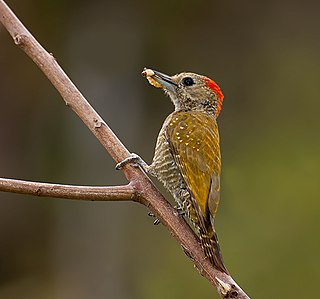
The little woodpecker is a species of bird in subfamily Picinae of the woodpecker family Picidae. It is found in every mainland South American country except Chile, Suriname, and Uruguay.

The collared antshrike is a species of bird in subfamily Thamnophilinae of family Thamnophilidae, the "typical antbirds". It is found in Ecuador and Peru.
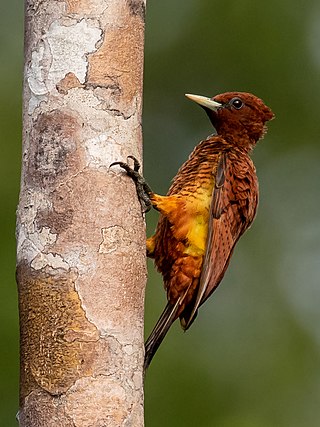
The scaly-breasted woodpecker, also known as the scale-breasted woodpecker, is a subspecies complex of bird in subfamily Picinae of the woodpecker family Picidae. It is found in Bolivia, Brazil, Colombia, Ecuador, Peru, and Venezuela.

The pale-crested woodpecker a species of bird in subfamily Picinae of the woodpecker family Picidae. It is found in Argentina, Bolivia, Brazil, and Paraguay.

The rufous-headed woodpecker is a species of bird in subfamily Picinae of the woodpecker family Picidae. It is found in Bolivia, Brazil, Ecuador, and Peru.

The waved woodpecker or variable woodpecker is a species of bird in subfamily Picinae of the woodpecker family Picidae. It is found in Bolivia, Brazil, Colombia, Ecuador, French Guiana, Guyana, Peru, Suriname, and Venezuela.

The campo flicker is a species of bird in subfamily Picinae of the woodpecker family Picidae. It is found in Argentina, Bolivia, Brazil, Paraguay, Suriname, and Uruguay.

The green-barred woodpecker or green-barred flicker is a species of bird in subfamily Picinae of the woodpecker family Picidae. It is found in Argentina, Bolivia, Brazil, Paraguay and Uruguay.
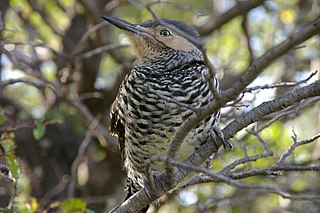
The Chilean flicker is a species of bird in subfamily Picinae of the woodpecker family Picidae. It is found in Argentina and Chile.

The spot-breasted woodpecker or spot-breasted flicker is a species of bird in subfamily Picinae of the woodpecker family Picidae. It is found in Panama and every mainland South American country except Argentina, Chile, Paraguay, and Uruguay.

The Andean flicker is a species of bird in subfamily Picinae of the woodpecker family Picidae. It is found in Argentina, Bolivia, Chile, Ecuador, and Peru.

The Antillean piculet is a species of bird in subfamily Picinae of the woodpecker family Picidae. It is endemic to the Caribbean island of Hispaniola that is shared by the Dominican Republic and Haiti.

The grey-crowned woodpecker is a species of bird in subfamily Picinae of the woodpecker family Picidae. It is endemic to western Mexico.

The golden-green woodpecker is a species of bird in subfamily Picinae of the woodpecker family Picidae. It is found in Panama and every mainland South American country except Chile and Uruguay.
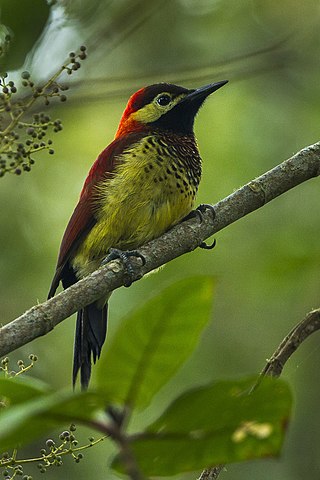
The crimson-mantled woodpecker is a species of bird in subfamily Picinae of the woodpecker family Picidae. It is found in Bolivia, Colombia, Ecuador, Peru, and Venezuela.

The bronze-winged woodpecker is a species of bird in subfamily Picinae of the woodpecker family Picidae. It is endemic to northeastern Mexico.
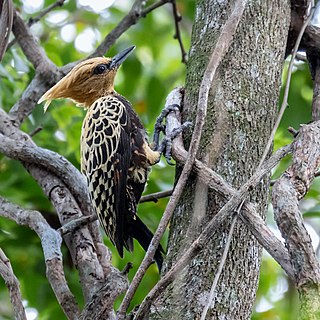
The ochre-backed woodpecker is a species of bird in subfamily Picinae of the woodpecker family Picidae. It is endemic to Brazil.
























